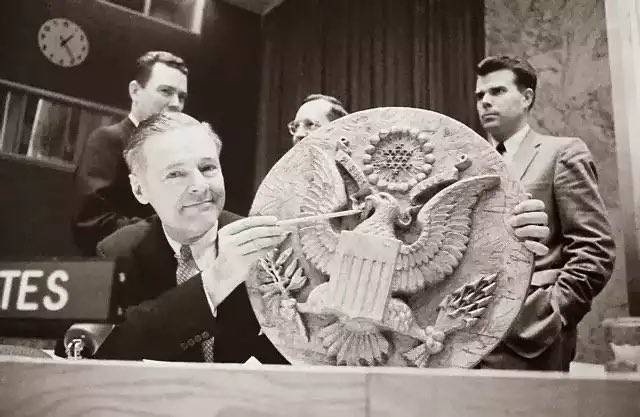In 1945, a group of Soviet schoolchildren presented a US ambassador with a carved US seal as a gesture of friendship. It hung in his office for seven years before discovering it contained a listening device.
The Thing, also known as The Great Seal Bug, was a passive covert listening device, developed in the Soviet Union and planted in the study of the US ambassador in Moscow, hidden inside a wooden carving of the Great Seal of the United States. It is called a passive device as it does not have its power source. Instead, it is activated by a strong electromagnetic signal from outside. The device was codenamed LOSS by the US and RAINDEER or DEER (ONEHb) by the Soviets.
On 4 August 1945, the Vladimir Lenin All-Union Pioneer organization presented a hand-carved replica of the Great Seal of the United States to US Ambassador Averell Harriman, as a gesture of friendship to the USSR's World War II ally. It hung in the library at the Residency Spaso House.
Unknown to the Americans, the carving contained an HF radio bug of a novel design, as it didn't have its power source and was not connected via wires. Instead, the device was illuminated by a strong radio signal from the outside, which powered and activated it. This arrangement gave the bug a virtually unlimited life and provided the Soviets with the best possible intelligence.
The bug was finally discovered by the US State Department in 1952, three ambassadors later, during the tenure of Ambassador George F. Kennan.
This was a CIA project that was commenced in the 1960s to spy on Russia. They chose a cat for the job, but what they didn’t take into consideration is the fact that cats are hard to train. The cat’s job was to eavesdrop on two men in a park outside the Soviet embassy in Washington, D.C.
The cat was wired up by a veterinary surgeon who implanted a microphone into the ear canal, a small radio transmitter at the base of the skull, and a battery buried in the flesh. It was a complex project that took five years to complete and consumed a whopping $20 million.
The project was closed in 1967 because the cat couldn’t obey directives. They initially believed they could train the cat but they were wrong.
In a parallel vein of espionage craftiness, during World War II, British intelligence used Operation Mincemeat to deceive Nazi Germany about the invasion of Southern Europe.
In 1943, the British planted a corpse with false documents off the coast of Spain, dressed as a military officer carrying supposedly confidential papers. The papers suggested that the Allies would invade Sardinia and Greece, diverting attention away from the actual target, Sicily. The deception was so effective that even after the invasion of Sicily had begun, German troops were still being diverted to other locations. Just like the Soviet Union's "Great Seal Bug,"
Operation Mincemeat exploited the enemy's trust and assumptions to gather intelligence and achieve strategic objectives, utilizing intricate techniques to deceive their opponents in an age before digital espionage.


